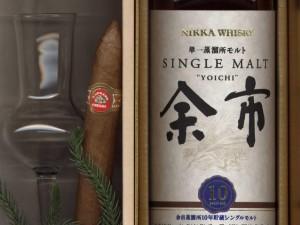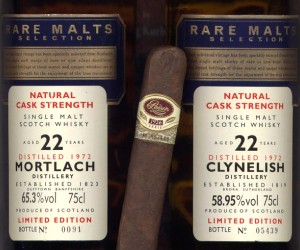Lifestyles
Whiskey Or Whisky 101 - The Basics Of A Great Drink (Part 1)

As a college student, I had my fair share of Jack Daniels sessions, but never cared for the taste, probably because all I did was shoot it. In another phase, I found I could drink from the bottle and forego the formality of the shot glass. One night, this somehow translated into me sipping it from the bottle, and lo and behold there was flavor, albeit followed by that harshness found in all strong liquor, a sensation I only tolerated because of the wonderful blanket of intoxication alcohol wraps you in.
Visiting the girlfriend's family in California, her uncle set a glass in front of me, filled with a mysterious light amber liquid, and instructed me to take a sip. I was amazed at how I could taste wood, honey, autumn and spring all in one sip, and warm my throat pleasantly without burning. It was then revealed to me that this elixir was Scotch whisky.
Immediately after that trip, my girl purchased a bottle of Johnnie Walker Black Label and kept it at her place, just to make sure I came over now and then. I tried it straight, tried it with ice, drowned it in water and tried mixing it.
So, now that you know where I'm coming from, I'd like to pose a few questions. I'm looking to purchase a few fifths of some of these tasty liquids for pairing with cigars. What Bourbons and Scotches would you recommend for a novice? I don't want to break the bank, but also don't want to buy the $9 fifths that are only good for marinating with.
Lastly, how do you drink your Bourbon and Scotch? What kind of glass do you use? And do you add any water of the liquid or solid variety?"
I'm no Bourbon expert. Linn is definitely the 'man with the golden palate' when it comes to the finest whiskies from Tennessee and Kentucky. But I'll nonetheless humbly suggest you begin exploring that particular spirituous arena by trying out some good basic Bourbons.
One major difference between Scotch and Bourbon to be aware of is the casks used in each for maturation. Where Bourbon ages exclusively in new charred American oak and is made predominantly from corn spirit, single malt Scotch usually goes the used barrel route to age its pure malted barley-based spirit. This means that you will normally encounter Scotch whiskies which have been aged in ex-Bourbon barrels, Sherry casks or a mixture of the two.
Once your palate is attuned to Scotch's unique style, you should explore some of the most revered malt whiskies in the world, those from the Isle of Islay. A glassful of Ardbeg or Lagavulin will tell you everything you need to know about real Scotch whisky. I'm not guaranteeing you'll fall in love with these, mind you. At least not right away!
Its an over-simplification to say that whiskey is distilled beer, yet that is exactly what it is. We'll come back to this later when we talk about mashbills.
OK, so somebody dumped a bunch of beer into a still, ran it through and called it whiskey. Who in the Sam Hell was that? There is a pissing contest that rages to this very day between the Irish and the Scots as to who first invented whiskey. A fair bit over a thousand years ago one or the other of these two fine Celtic cultures made the first whiskey, and there are no written records to tell just who did it first.
I tend to side with the Irish on this issue, as I can just see some Irishmen looking at an alembic, or pot-still as its now known, after unloading it from a Roman ship and asking, "What is it, Sean?, whereupon Sean replies, I dunno, but let's fill it full of beer and see what happens!"
The Alembic was invented in ancient Egypt and used for distilling down colors for use in metalcraft, along with tinctures for use in medicines of the day. The Egyptians apparently never thought to run some wine or beer through the still, or at least we have no record of it if they did.
The Alembic refers to the hand-hammered sheet copper top of the still that was formed to be about the size of a person's head. A long beak or snout protruded out, and this was where the distillate emerged. The Alembic press-fit snugly onto the top of the pot. The pot itself was a large earthenware piece heated indirectly while immersed in a wet sand bath, and contained within a mud-brick structure not unlike, say, a brick barbecue pit. A fire underneath heated the whole assembly. What we know today as the condenser coil or worm had not, as yet, been invented.
Eventually, the Romans conquered the known world. Again, the alembic found continuous employment in distilling colors for metals and compounds for medicine. And just like the Egyptians, the Romans didn't toss any ardent potables through the thing to see what came out. Since the Romans were mastercraftsmen of wood, stone, and metal, it is likely that they dispensed with the Egyptian earthenware pot in favor of a less fragile and much more robust all-copper pot. Some Roman put an alembic on a ship and sailed for either Ireland or Scotland. And this is where the aforementioned pissing contest begins.
But let's backtrack a bit to that beer business, and how it relates historically to whiskey. Once man had passed from the Stone Age into the Agricultural Age, civilizations arose - and just about every civilization brewed beer. People used the cereal grains at hand, be they rice, wheat, oats, corn or barley. In the case of the western Celtic tribes, barley was what grew best in the chilly, wet climates of both Scotland and Ireland. Since beer is a malted beverage, some of the grain used to make it has to be malted. Malting is simply the germination and drying out of a grain.
When the malted grain is ground up, it's then cooked in water, and the liquid drained off. This liquid is called a wort. The wort needs to ferment, and wild yeasts in the air or commercial cultivated yeasts trigger this process nicely.
Instead of taking the fermented wort to the brew kettle for beer, off it goes to the still to become whiskey. If you're going to make whiskey, the fermented wort is now called 'distiller's beer'.
Eventually, all sorts of advances were made in distilling apparatuses, with the condensing coil or worm being chief among them. This particular advance allowed for quicker and more efficient whiskey making.
Then, in the 1830's, Aeneas Coffey patented the continuous or column still that is used in the making of American whiskies today, as well as Scottish grain whiskies.

I agree we should probably credit the Irish with lighting the first fires underneath pot-stills filled with barley brew, though a group of them wasted little time hopping on over to Scotland with their new-found elixir.
And let us not forget the prominent role the monks played in all of this, for they were more than likely the ones who 'safeguarded' the craft of distillation as it moved westward.

I am grateful to have all at hand and in glass."

So why do most single malt Scotches not taste inordinately sweet? And where does that balancing dryness originate? One contributing factor is how the germinated barley is dried before being ground into grist. If coal or peat fires are used to dry a portion of the grain, they will infuse the barley with a dry smoky quality. Secondly, there is the cask factor. Generally speaking, the longer a whisky is exposed to wood, the drier in taste it will become. And thirdly, there is the matter of the location of the warehouses where the whisky is matured. A whisky lying in a barrel near the sea will, over time, acquire a dry, salty characteristic to balance the sweetness of the malt.
Oftentimes, the water used by the distillery to soak the barley and reduce the spirit courses over stone or peat, and can pick up traces of these on its way to the site.
The shape of the pot-stills within the stillhouse is critical to the style of spirit which will emerge. As a rule, tall, slim stills produce a more delicate spirit while short, dumpy stills produce a richer, oilier spirit. As always, however, there are exceptions to the rule.
Then there's the climate about the distillery. If you can stand outside the distillery buildings and notice a seaside saltiness in the air, chances are the whisky will also exhibit a briny quality.
With all of these tools at its disposal, the distillery can manipulate them in order to acquire a uniquely flavored spirit.
My first bit of advise to you is to avoid blended whiskies altogether, no matter what country they come from. Most blends use very little actual whiskey, and are mostly water and neutral grain spirits Vodka of sorts, if you will with just enough whiskey to add some flavor and color. Some even use caramel for color. All of these aberrations will give you one hell of a hangover/headache. And if taken in excess, they will make you sick as a dog. Think of the blends as gasohol with a shot of whiskey and caramel. Just say no to blends. Got it?
Always go with a straight whiskey. Straight means that nothing has been added to the whiskey, as in unadulterated. Adding enough water to bring the barrel proof spirit down to bottling proof is OK.
In the world of Scottish and Irish whiskies, the term 'single malt' usually means straight or unadulterated whiskey. It also means that the whiskey is from a single distillery, and has not been mixed with any other distillers' whiskies. In most, but not all cases, straight bourbon whiskey is the equivalent of single malt.
So always drink straight or single malt whiskies. Both your mind and body will thank you for leaving the vile brain killing blends on the shelf."
Linn Spencer (Linn) is an acknowledged expert in American liquors. His intimate acquaintance with the distillers and distilleries of the eastern United States has earned him a reputation as a tireless advocate for the virtues of their whiskies. Aside from his published articles in The Bourbon Country Reader, Linn has also helped innumerable Cigar Weekly members to discover the myriad pleasures of Bourbon, Rye and Tennessee whiskies.
Doug Kuebler (jazznut) is a committed taster and collector of wines and spirits, particularly Scotch whiskies. His recently published 2-volume book, entitled The Tumbler's Guide to Single Malt Scotch Whisky, is available through Topeda Hill Publishing




